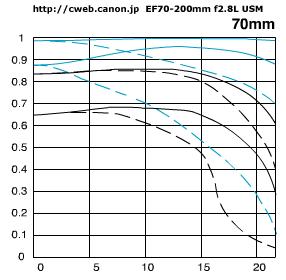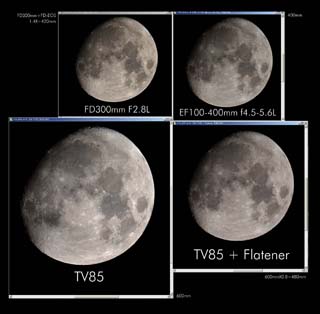HOME
About the LENS for Digital SLR
Photographer : Daisuke Tomiyasu
December 7, 2005
Today we find so many web pages on the Internet that talk about lenses for digital SLR cameras. However, it's hard to find opinion with supporting data you can trust. The worst senario is the opinion that compares lenses in the wrong way. So I decided to write a little bit about it here using the Canon EF Zoom 100-400 f4. 5-5.6L IS USM.
1. Let's check MTF graph
Almost every lens maker shows the MTF graph on their web page. So let's compare the data for the lenses you are looking for.
DO
- Compare lenses in the same catagory. For example, if you are looking for a zoom lens, compare the zoom lenses with the focal length you need.
- Let's talk about value. If one of the lenses has a better MTF result, is it really necessary to pay more for a lense that costs more if the lower priced one has a higher MTF result?
- When you are looking at information on a web page, check to make sure the information is supported by facts such as examples by comparison or manufacturer data. If there is no evidence to back up the information, then the story is hard to trust. Make sure the information is factual and has technical evidence to back it up.
DO NOT
- Do not compare lenses in different catagories like a zoom with a single focus length lens. These two lenses are different stories. Consider if you need both lenses. If carrying two lenses is not a problem that's great. But still you have to think about the time it takes switch lenses quickly enough to get the shot you want. The shutter opp does not wait for you to change lenses. And if you are going into dusty, rainy or snowy conditions when you change lenses, you are faced with the possibility of creating a problem inside the body when the lens change occurs. For me, these are enough reasons to choose buying the zoom. Your best shot in good framing and shutter quality is 1000 times better than a poor shot with just a good quality lens.
- Do not think that MTF is everything. Lenses have individual specialties. Lenses for photographs do not depend totally on results of a calculation. Just because a particular lens has the best MTF graph rating doesn't mean you are going to get that particular result. Because, remember, these lenses are result of mass production. If you are lucky, possibly your lens will be the best one. However, trust your own capabilities and be happy with your result.
 For example...say you are looking for a 400mm Canon lens. Canon has several 400mm lenses to choose from. But only one zoom lenses, 100-400mm f4.5-5.6L IS USM. All of the other three 400mm lenses are single focal length. Check these prices out! The EF400mm f2.8L IS USM is priced 4 times higher than the 100-400mm zoom. When you compare the zoom lenses by MTF at 100mm, look at the graphics at the right. Is the 100-400mm so bad compared to the 70-200mm?? For your use, can you justify paying four times as much for the lens? It really depends on what you can afford. In that price range, the 400mm f5.6L USM is cheaper than the 100-400mm lens. But the 400mm f5.6 possibly produces a poorer result than the 100-400mm because without the IS. So...
For example...say you are looking for a 400mm Canon lens. Canon has several 400mm lenses to choose from. But only one zoom lenses, 100-400mm f4.5-5.6L IS USM. All of the other three 400mm lenses are single focal length. Check these prices out! The EF400mm f2.8L IS USM is priced 4 times higher than the 100-400mm zoom. When you compare the zoom lenses by MTF at 100mm, look at the graphics at the right. Is the 100-400mm so bad compared to the 70-200mm?? For your use, can you justify paying four times as much for the lens? It really depends on what you can afford. In that price range, the 400mm f5.6L USM is cheaper than the 100-400mm lens. But the 400mm f5.6 possibly produces a poorer result than the 100-400mm because without the IS. So...
2.Trust your own result
In my opinion, the EF100-400mm f4.5-5.6L IS USM is one of the better lens. I have the FD300mm f2.8L and still the EF 100-400mm is almost the same quality or even better when I compared them to each other. When you add the Extender 2x, you can carry 100mm to 800mm focal length easily. Do you still want to carry EF400mm f2.8L IS USM weight 5.730 grams?
 On the other hand, depending on what you want to shoot, telescopes are much sharper than photo lenses. So just like the long focal lenses, you might add the telescope as a candidate to your shopping list. This works not only for the night sky but also when you are shooting smaller subjects like birds. One of the reasons I think the telescope is better is because it doesn't use a focus ring or an iris, there is no mechanism to relation with camera body.
On the other hand, depending on what you want to shoot, telescopes are much sharper than photo lenses. So just like the long focal lenses, you might add the telescope as a candidate to your shopping list. This works not only for the night sky but also when you are shooting smaller subjects like birds. One of the reasons I think the telescope is better is because it doesn't use a focus ring or an iris, there is no mechanism to relation with camera body.
So this is my advice. If you are an amateur photographer, buy the 100-400mm zoom then go somewhere in the world you like to take photos several times. Because you now have saved enough money to do that when you could have spent all your money on the EF400mm f2.8L.
If you are a professional photographer and there is no question that you need the
400mm focal length, then you should buy that lens to get the shot you want. At the same time, if you don't have an assistants help, you have to think about switching if
you are going to buy a single focus lens.
Needless to say, the 400mm f2,8 L IS USM is one of the best telephoto lenses in the world. However, when an amateur takes his best shot, you can't say "this picture has better quality because of the lens." It doesn't mean the picture is better or your skill is better. It only means "lens is good."
3. Is 100-400 lens "Dust Trombone"?
The answer is "No". Not only 100-400 but also at all L lenses. Canon are not so stupid to make that for professional users. And it is one of the reason to named with "L" sign.
I have no idea why some people says this. Because I've never experienced dust problem with Canon lens even not L lens. However, for argument's sake, let's assume that any lenses which has dust problem because forward/backward zooming system, still L quality shows good result at dust and wet proof. Because Canon made it as it is. Moreover, used be I was Nikon F or F2 user and I had 70-210 zoom lens. It was designed exact "Dust Trombone" type but had no problem at all.
If the lens system has dust problem by vacuum the air, it is even for all lenses. Let you think about moving part. Lenses are moves any way and needs inside air out or outside air in for move the units because these are not air tight except camera for underwater.
All cameras and lenses are fine mechianism. That kind of items are not accepts too dusty environment. But cameras are really doing good to against it, I think. If you do not want to see the dust inside lens ever then let you have underwater cameras like Nikonos. But still dusts comes into body or inside lens when you remove the lens because back side of the lens unit are not dust or water proof. We can use very speedy and smooth zooming by the design of EF 100-400mm L and I've never had a dust problem least. If you still feel problem about that, let you ask to Canon, directly. They will listen from users very carefully and kindly then gives you the answer about "Dust Trombone" problem.
Copyright © Daisuke Tomiyasu 2005 All Rights Reserved
 For example...say you are looking for a 400mm Canon lens. Canon has several 400mm lenses to choose from. But only one zoom lenses, 100-400mm f4.5-5.6L IS USM. All of the other three 400mm lenses are single focal length. Check these prices out! The EF400mm f2.8L IS USM is priced 4 times higher than the 100-400mm zoom. When you compare the zoom lenses by MTF at 100mm, look at the graphics at the right. Is the 100-400mm so bad compared to the 70-200mm?? For your use, can you justify paying four times as much for the lens? It really depends on what you can afford. In that price range, the 400mm f5.6L USM is cheaper than the 100-400mm lens. But the 400mm f5.6 possibly produces a poorer result than the 100-400mm because without the IS. So...
For example...say you are looking for a 400mm Canon lens. Canon has several 400mm lenses to choose from. But only one zoom lenses, 100-400mm f4.5-5.6L IS USM. All of the other three 400mm lenses are single focal length. Check these prices out! The EF400mm f2.8L IS USM is priced 4 times higher than the 100-400mm zoom. When you compare the zoom lenses by MTF at 100mm, look at the graphics at the right. Is the 100-400mm so bad compared to the 70-200mm?? For your use, can you justify paying four times as much for the lens? It really depends on what you can afford. In that price range, the 400mm f5.6L USM is cheaper than the 100-400mm lens. But the 400mm f5.6 possibly produces a poorer result than the 100-400mm because without the IS. So...